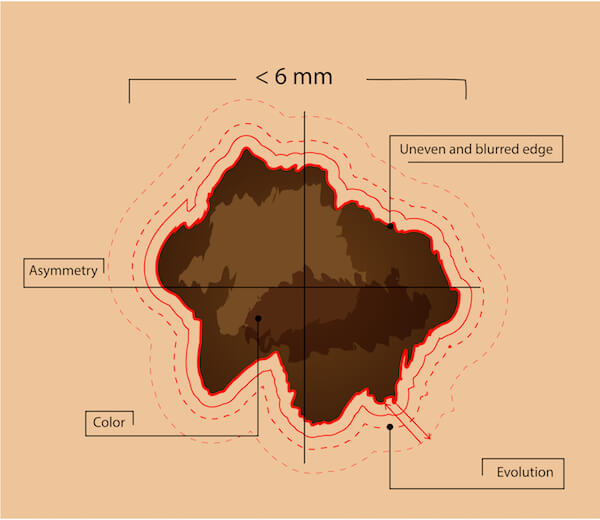Skin Cancer
Consultations offered at our two convenient locations in Phoenix and Scottsdale

Skin cancer is, simply put, the abnormal growth of skin cells. Skin cancer is caused by unrepaired DNA damage that triggers mutations. These mutations lead the skin cells to multiply rapidly and form malignant tumors.
The main types of skin cancers are basal cell carcinoma (BCC), squamous cell carcinoma (SCC), melanoma, and Merkel cell carcinoma (MCC). The greatest contributing factor to the formation of skin cancer is over-exposure to ultraviolet radiation. Several factors influence the amount of ultraviolet radiation reaching the earth’s surface, including ozone depletion, latitude, altitude, and weather conditions.[1]
About
Skin cancer is the most prevalent of all types of cancers. Fair-skinned individuals who sunburn easily have the greatest risk of developing skin cancer. Other important risk factors include the use of tanning devices, genetics, repeated medical and industrial x-ray exposure, immunosuppression, scarring from diseases or burns, and occupational exposure to compounds such as coal, tar, and arsenic.
The United States Preventative Services Task Force recommends that clinicians selectively offer counseling to adults older than 24 years with fair skin types about minimizing their exposure to UV radiation to reduce their risk of skin cancer.[2]
You should develop a regular routine to inspect your entire body for any skin changes.
If a growth, mole, sore, or skin discoloration appears suddenly or begins to change, contact Phoenix Skin Medical, Surgical & Cosmetic Dermatology to have it checked by our medical professionals. With offices in Phoenix and Scottsdale, slaying your skin cancer has never been more efficient and convenient for Arizonans.
Call (602) 222 – 9111 for our Phoenix office or (480) 473 – 9111 or our Scottsdale office.
Phoenix Skin specializes in all areas of adult and pediatric medical, surgical and cosmetic dermatology. Our board-certified physicians and physician assistants are the finest in their fields and strive to bring you the latest techniques and procedures available through our state-of-the-art facilities.
Stay up-to-date on any events and specials by following Phoenix Skin on social media. You can find us on Twitter, Facebook, and Youtube.
We look forward to meeting you.
The ABCDE’s of Melanoma
- Asymmetrical
- Misshapen
- Border
- Odd or poorly defined bordering
- Color
- Pigmentation differs from one area to another; tan and brown or black shading; can also be white, red, or blue
- Diameter
- While melanomas are usually bigger than 6mm in diameter when diagnosed, they can be smaller. If you see a differing mole that changes, itches, or bleeds, you should contact Phoenix Skin Dermatology asap.
- Evolving
- The mole morphs in shape, size, and color over time.
Primary Types of Skin Cancer
Basal Cell Carcinomas
According to the American Cancer Society, this is the most common form of skin cancer, calculating nearly 80% of all cases. These cancers happen in the underlying cells below the surface of the skin.
Treatments usually include prescription creams and surgery.
Squamous Cell Carcinomas
This form of skin cancer accounts for nearly 20% of all cases. Squamous cells can be found in the throat, the digestive and respiratory linings, and organs such as the liver and kidneys.
Treatments may include surgery, chemotherapy, and radiation.
Merkel Cell Carcinomas
Although rare, Merkel cell carcinomas are a very destructive form of skin cancer. Merkel cells are the cells that give the skin the ability to sense touch. They are found below the skin next to the nerve endings.
Treatments can include surgery, radiation, immunotherapy, and sometimes, chemotherapy.
Kaposi’s Sarcoma (KS)
This skin cancer may look like purplish blotches or lesions on the skin, usually on the face or legs. It may also materialize inside the mouth or in the lymph nodes. In some rare cases, lesions may appear in the lungs, causing respiratory issues.
Treatments can include radiation, chemotherapy, and medications.
Lymphoma of the Skin
Lymphoma is a cancer of the lymphatic system. It can form in various locations in the body, like the spleen, lymph nodes, thymus, and skin. It can look likes red or purple patches, moles, or pimples on the skin that may become irritated or an open sore. Other symptoms may include tiredness and weight loss.
Treatments include chemotherapy, radiation, and prescription creams.
Melanoma
Melanoma is considered a rare but very aggressive form of skin cancer. It accounts for about 2% of all skin cancers but is responsible for most skin cancer deaths. It develops in the melanocytes, the underlying cells below the skin’s surface that give skin its color. Exposure to UV rays is a leading cause of melanoma. Unlike most skin cancers, melanoma may progress to parts of the body not usually exposed to the sun, like the groin, armpits, and bottoms of feet.
Melanoma is more prone to travel than other skin cancers. The melanoma cells usually travel to the lungs, liver, bone, and brain.
Treatments include surgery, radiation, medications, and sometimes, chemotherapy.
Cost
For a current and complete rundown of our insurance providers, please consult our comprehensive listing page.
Financing options are also available for qualified patients.
If you enjoyed learning how to spot skin cancer, we recommend checking out the Phoenix Skin Blog. You’ll find all sorts of great content like informative articles, breakdowns of procedures, beauty tips, and much more.
We look forward to seeing you.
FAQ
What is skin cancer?
Skin cancer is the abnormal growth of damaged skin cells.
What causes skin cancer?
Most skin cancer is caused by exposure to ultraviolet (UV) radiation from the sun or tanning beds. Cells can also be damaged by genetically inherited DNA mutations or cell replication errors, or they may develop in patients with suppressed immune systems, such as those who have received organ transplants or were infected with the HIV virus.
What is ultraviolet radiation?
Ultraviolet radiation is part of several different types of light that are emitted by the sun. Most of the ultraviolet light that reaches the earth is UVA, the long-wave rays that penetrate the skin deeper than the short-wave UVB rays. These powerful rays can enter the skin’s deepest layers, where melanocytes (skin cells that regulate skin color) are located. These melanocytes take in UVA, producing melanin, which darkens the skin. Too much UVA can damage melanocytes, which can cause melanoma. UVB rays are not nearly as prevalent or potent, but they may burn the skin’s outer layers.
Is melanoma skin cancer?
Yes, melanoma is a type of skin cancer. It is considered a rare but very aggressive form of it. It accounts for about 2% of all skin cancers but is responsible for most skin cancer deaths. It develops in the melanocytes, the underlying cells below the skin’s surface that give skin its color. Exposure to UV rays is a leading cause of melanoma. However, unlike most skin cancers, melanoma may progress to parts of the body not usually exposed to the sun, like the groin, armpits, and bottoms of feet.
Melanoma is more prone to travel than other skin cancers. The melanoma cells usually travel to the lungs, liver, bone, and brain.
What are the warning signs for skin cancer?
Skin cancer typically starts as a seemingly benign, painless spot, sore, or rash on the skin. If that sore or rash happens not to heal, or if it changes color or becomes misshapen, then it may be skin cancer.
Basal cell carcinomas on the head or neck can develop as a pale patch of skin or a waxy bump. On the chest, it can appear more like a brownish scar or flesh-colored lesion. These spots can bleed or ooze and become crusty.
Squamous cell carcinomas can develop as a lump on the skin. However, unlike a basal cell carcinoma’s smooth appearance, these lumps can be rough on the surface. The cancer may also progress to a reddish, scaly patch.
Merkel cell carcinoma can look like a dome-shaped lump on the skin that develops rapidly. These bumps are typically painless and can appear red or purple.
Melanoma can look like a dark spot on the skin. It can change shape and color and bleed as it evolves.
It can be challenging to tell if a skin growth is a mole, a harmless growth, or skin cancer. That’s why we urge you to report any suspicious or fast-growing spots to your doctor.
What does it mean when cancer has “metastasized?”
Metastasis is when the cancer cells break away from the main tumor and spread elsewhere to establish new tumors in separate parts of the body.
Basal cell carcinomas and squamous cell carcinomas rarely metastasize. But melanoma is among many cancers that can spread, or metastasize, to other parts of the body. Typically, metastatic melanoma travels to the brain, lungs, bones, and/or lymph nodes. Metastatic skin cancer can demand large-scale surgery, chemotherapy, and other treatments. You may also want to think about talking to your doctor about therapies that can help you manage symptoms and side effects. Metastatic cancer is different than recurring cancer, which is cancer that repeatedly returns to the same part of the body.
Read about our Medical Director Dr. Lee Laris. Contact Us to schedule and appointment for an expert consultation.
References
- Narayanan, D. L., MPH, CPH, Saladi, R. N., MD, & Fox, J. L., MD, FAAD. (2010). Review: Ultraviolet radiation and skin cancer. International Journal of Dermatology, 49(9), 978-986. doi:https://doi.org/10.1111/j.1365-4632.2010.04474.x
- US Preventive Services Task Force. Behavioral Counseling to Prevent Skin Cancer: US Preventive Services Task Force Recommendation Statement. JAMA. 2018;319(11):1134–1142. doi:10.1001/jama.2018.1623







